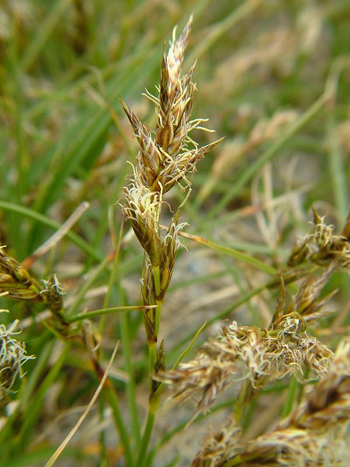Contents:
Common Names | Parts Usually Used | Plant(s) & Culture | Where Found | Medicinal Properties | Biochemical Information
Legends, Myths and Stories | Uses | Formulas or Dosages | Warning | Bibliography
Scientific Names

- Carex arenaria L.
- Sedge family
Common Names
- German sarsaparilla
- Red couchgrass
- Sand sedge
- Sea sedge
Parts Usually Used
Rootstock and roots
Back to Top
Description of Plant(s) and Culture
Red sedge is a small, perennial herb; the creeping rootstock grows to lengths of 30 feet but is very thin. It produces stiff, grooved, triangular flower stalks sheathed with linear leaves which separate from the stalk near the bottom or at various points along its length. Small terminal spikes of tiny, green, inconspicuous flowers appear during May to June.
Back to Top
Where Found
Grows on riverbanks, wet embankments, shorelines, and other sandy soils from France to northern Europe.
Back to Top
Medicinal Properties
Diaphoretic, diuretic
Back to Top
Biochemical Information
Silicic acid
Back to Top
Legends, Myths and Stories
A different variety of sedge (C. ex-siccata) or Tall swamp sedge, was used by Native Americans to make very fine baskets. The root of the sedge is used. The Native American name: Matso-zump. The root is buried in still warm ashes, with water added. This makes a fine black.
Also root baskets are made from roots of a sedge (C. mendocinoensis), Pomo name, “Kahoom”, or water-gift. These long roots sometimes reach 5 or 6 feet in length. They are soaked overnight in water, and the weaver peels off the bark or outer skin and rolls it in small coils. The remaining root can be split into many strands, used as “Boms” for foundation. There are sedges, called blackroot sedge, which have a central section, coal-black, which color can be deepened by burying in manure of in blue mud.
Nebraska sedge (C. nebraskensis), Cut-your-finger, “So-yo-toi-yis”, a favorite food of buffalo, is tied around the horns of the buffalo head in the Sun Dance.
Back to Top
Uses
The root has sometimes been used for gastro-intestinal catarrh, colic, chronic constipation, and for coughs and hoarseness. In mild cases of tuberculosis, the rootstock’s silicic acid content may be useful in stabilizing scarred tissue. For various skin problems, take red sedge as a diaphoretic tea.
Back to Top
Formulas or Dosages
Decoction: boil 2 tbsp. rootstock and roots in 1 cup hot water. Take 1 cup per day, warm.
Cold extract: soak 2 tsp. rootstock and roots in 1 cup cold water for 8 hours. Take 1 cup per day.
Back to Top
Warning
Do not use when acute kidney inflammation is present.
Back to Top
Bibliography
![]() The Herb Book
The Herb Book, by John Lust, Bantam Books, 666 Fifth Avenue, New York, NY. copyright 1974.
![]() Indian Uses of Native Plants
Indian Uses of Native Plants, by Edith Van Allen Murphey, Meyerbooks, publisher, PO Box 427, Glenwood, Illinois 60425, copyright 1958, print 1990
![]() Webster’s New World Dictionary
Webster’s New World Dictionary, Third College Edition, Victoria Neufeldt, Editor in Chief, New World Dictionaries: A Division of Simon & Schuster, Inc., 15 Columbus Circle, New York, NY 10023
